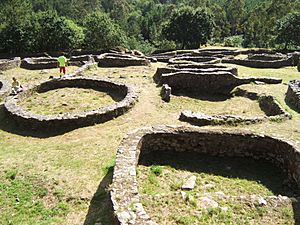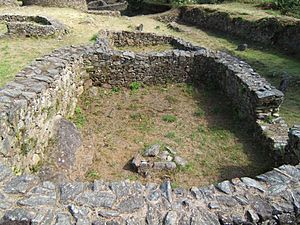Castro de Borneiro facts for kids
Castro de Borneiro is an amazing ancient site in Galicia, Spain. A castro is like an old, walled village from the Iron Age. This special place shows us how people lived during the Castro culture in Northern Spain. While the Castro culture started as early as 900 BCE, this particular village was used from about 400 BCE to 1 BCE. It's a perfect example of these ancient settlements and has been carefully studied by archaeologists.
Contents
Where is Castro de Borneiro?
Castro de Borneiro is found in a place called Castro (also known as A Cibdá). This area belongs to the parish of Borneiro, in the town of Cabana de Bergantiños in La Coruña, Spain. It's easy to get to, just 500 meters from the AC-430 road, which connects Ponteceso and Baio.
What is Castro de Borneiro like?
This ancient village sits on a hillside about 200 meters (650 feet) high, facing east, and is close to a stream. It was the first castro in Galicia to be scientifically dated using a method called Carbon-14 dating. This special test helps scientists figure out how old things are. So far, no signs of Romanization (meaning, influences from the Roman Empire) have been found here.
Discovering the Past
The site was first found in 1924 by Isidro Parga Pondal and Pérez Bustamante. Digging to uncover the past began in the 1930s, led by Sebastián García-Paz. Later, in the 1970s, Jorge Juan Eiroa continued the work. Even more detailed studies happened in the 1980s with Ana Romero Masià leading the way.
Archaeologists found many interesting things here, like:
- Pieces of local pottery
- Vases made of bronze and iron
- Old stone walls
- Tools for melting metal
- Glass beads
All these amazing objects are now on display at the Archeological and Historical Museum of La Coruña. So far, 36 different buildings or structures have been uncovered, which is about three-quarters of the whole village!
Inside the Village Walls
The main part of the castro is about 90 meters (295 feet) long and 55 meters (180 feet) wide. It was protected by a ditch and two strong defensive walls. On the east side, the steep hillside itself acted as a natural defense, so no walls were needed there.
Outside the Walls
There's also an area outside the main walls, near the entrance to the castro. This part has a large, long house, two fountains with drains, and a round oven. This oven probably had a dome-shaped roof back then. The houses in Castro de Borneiro are either round or rectangular with rounded corners. They are quite large compared to houses found at other similar sites.
Just a few kilometers from this ancient village, you can also find the Dolmen de Dombate, another fascinating historical site.
See also
- Castro Culture
- Oppidum
- Castros in Spain
- The Lighthouse Way
 In Spanish: Castro de Borneiro para niños
In Spanish: Castro de Borneiro para niños



